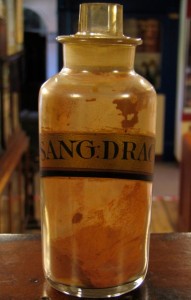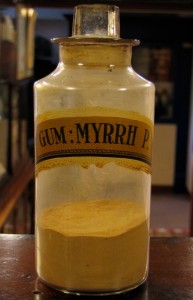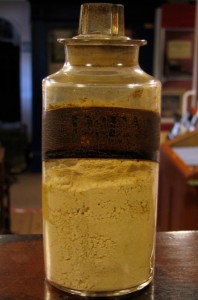Glass bottles: powder rounds
.
The Christopher Pharmacy at Bradford on Avon Museum, Wiltshire
.
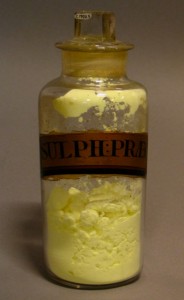 Powder rounds are cylindrical bottles which have a wide mouth so that a spoon could be used to scoop out amounts of the contents. The bottles are usually mouth-blown, so have the pontil mark on the base where a rod was fixed so that the neck could be formed at the other end; in the poshest bottles the mark was polished away afterwards. The glass lids have been ground into the mouth so a very tight seal has been made.
Powder rounds are cylindrical bottles which have a wide mouth so that a spoon could be used to scoop out amounts of the contents. The bottles are usually mouth-blown, so have the pontil mark on the base where a rod was fixed so that the neck could be formed at the other end; in the poshest bottles the mark was polished away afterwards. The glass lids have been ground into the mouth so a very tight seal has been made.
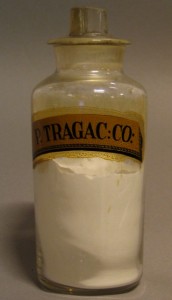 The bottle on the left is labelled SULPH:PRAEC: which is sulphura praecipitata, usually called flowers of sulphur. It is obtained by heating raw sulphur and a fine powder is deposited where it becomes cooler. This also happens in nature around volcanic vents. Flowers of sulphur were mainly used in fungicides, whether for skin complaints or on garden plants.
The bottle on the left is labelled SULPH:PRAEC: which is sulphura praecipitata, usually called flowers of sulphur. It is obtained by heating raw sulphur and a fine powder is deposited where it becomes cooler. This also happens in nature around volcanic vents. Flowers of sulphur were mainly used in fungicides, whether for skin complaints or on garden plants.
On the right is a powder round labelled P:TRAGAC:CO: containing powdered tragacanth gum, which is made from the dried sap of the roots of leguminous plants of the genus Astragalus from the Middle East. Its main uses are as a thickener and a binder and has the food additive number E413. The Christopher shop would have used it in binding together dry powders for making pills.
SANG:DRAC: on the label of this bottle of red powder stands for sanguis draconis, meaning literally “dragon’s blood”. No dragons were involved however, as this is the name for a resin that came originally from the dragon tree, Dracaena draco, of the Canary Islands, but also other related trees. Medicinally, it has various uses against ulcers, skin complaints and an antiviral. It is also used as a dye and is notably the colouring of varnish used for violins and for masking parts of photographic negatives.
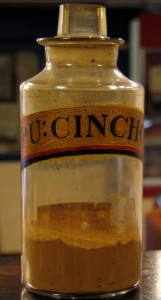 PU:CINCHON: is pulvis cinchonae, powdered bark of the South American tree Cinchona officinalis. This contains various alkaloid chemicals, of which the most important is quinine, a chemical which interferes with the multiplication of the parasite that causes malaria. Quinine is of course the bitter flavouring of tonic water, originally drunk against malaria.
PU:CINCHON: is pulvis cinchonae, powdered bark of the South American tree Cinchona officinalis. This contains various alkaloid chemicals, of which the most important is quinine, a chemical which interferes with the multiplication of the parasite that causes malaria. Quinine is of course the bitter flavouring of tonic water, originally drunk against malaria.
.
.
GUM:MYRRH:P: is gumma myrrhae pulverenta, or powdered gum of myrrh, which is a resin exuded by plants of the genus Commiphora. It is sweetly scented and has been used in flavouring and heated as an incense. It was one of the incenses that were so important in ancient trade and one of the gift offered by the Magi. Medicinally, it is used in mouthwashes and toothpastes to treat gum disease and in liniments for treating bruising and abrasions.
.
.
The label on the bottle on the right is difficult to read because the gum covering it has blackened with age, but it says ACID TANNIC. Tannic acid is present in many plants, especially those with strongly-coloured wood and bark. It a substance of the type called polyphenols and is in fact only very weakly acidic. It is often used in colouring as a dye. Its medical uses are limited to the treatment for poisoning and of chemical burns.


